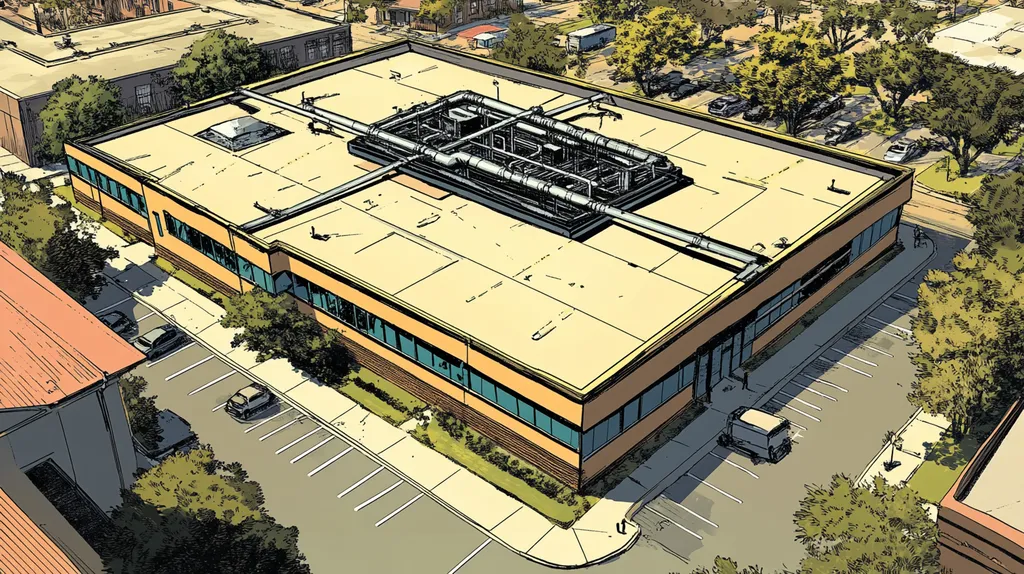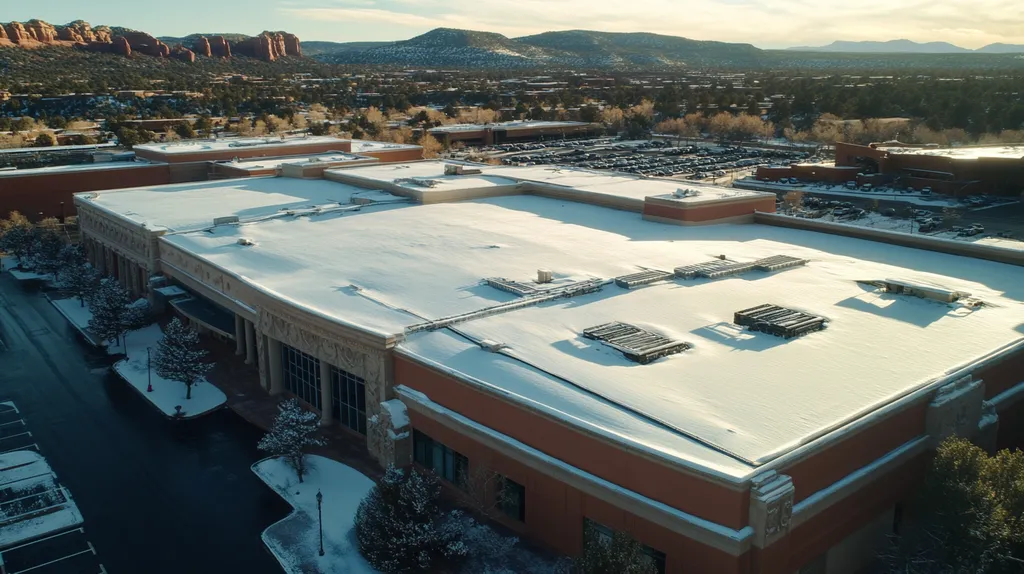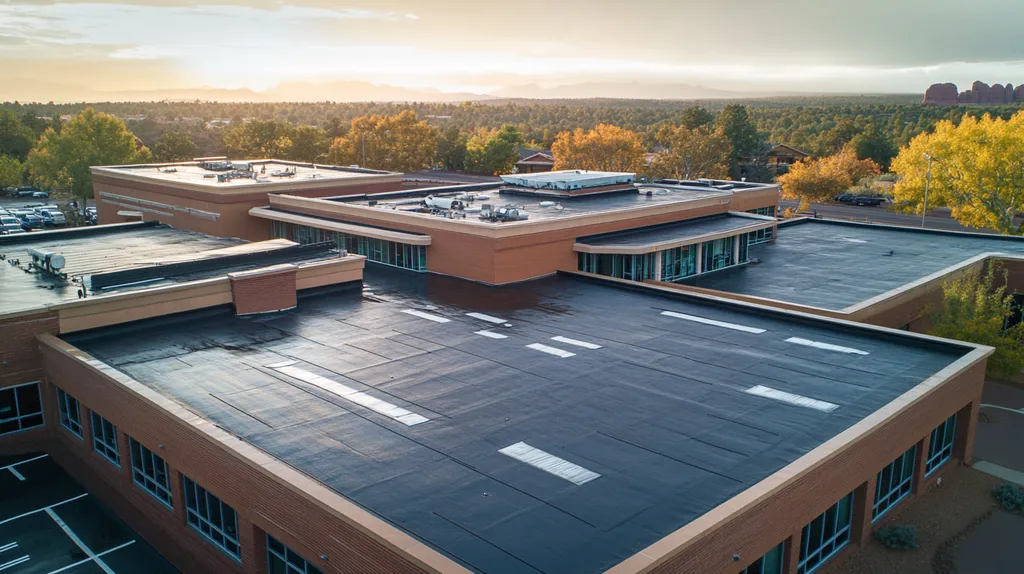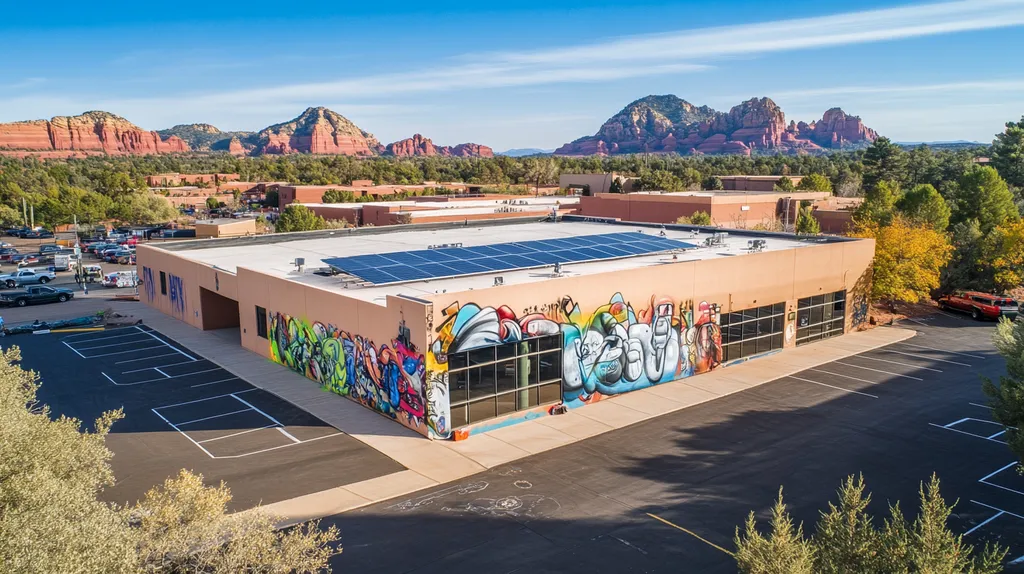In today’s industrial landscape, where roofing failures cost businesses over $2.5 billion annually, selecting the right roofing materials has never been more critical for facility operations and safety.
From extreme weather events to rising energy costs, industrial property owners face mounting challenges that demand informed decisions about roofing materials and systems.
This comprehensive guide examines the crucial factors that influence industrial roofing material selection, exploring everything from fundamental material properties to advanced optimization strategies that can significantly impact long-term facility performance and operational costs.
SECTION 1: FUNDAMENTAL CONCEPTS
Selecting the correct roofing material for industrial buildings is a crucial step that can greatly influence operational costs and overall building performance. Research reveals that poor material choices can spike energy expenditures by as much as 30%. This section delineates key concepts that affect material selection, including various types of roofing materials, the impact of climate and weather conditions, and the importance of complying with local building codes. Grasping these concepts is essential for property owners aiming to protect their investments while making financially sound decisions.
Understanding Roofing Material Types
Industrial roofs come in a variety of styles, each offering specific benefits and drawbacks. Popular materials include TPO, EPDM, metal, and built-up roofing. Familiarity with these options empowers property owners to make choices based on factors like durability, life expectancy, and maintenance requirements.
TPO (Thermoplastic Olefin) is particularly favored for its energy efficiency and affordability, making it a go-to for many facilities. In contrast, EPDM (Ethylene Propylene Diene Monomer) boasts exceptional weather resistance, especially in extreme temperatures. Metal roofing, on the other hand, is recognized for its incredible longevity and strength.
Different types of roofing materials also exhibit distinct performance characteristics, including insulation properties, chemical resistance, and vulnerability to UV damage. Selecting the right material is essential for enhancing insulation efficiency and reducing long-term costs.
Moreover, understanding how these materials perform in specific applications is crucial. Various industrial environments may demand unique features, such as fire resistance or superior waterproofing, which can significantly impact the final selection.
Climate and Weather Considerations
The local climate is a major factor that influences roofing material selection. For example, regions that contend with extreme heat should consider reflective materials that can lower cooling costs. Meanwhile, areas with heavy snowfall need roofs designed to endure the extra weight.
Humidity is another significant variable. In damp climates, the chance of mold and mildew increases, necessitating the use of materials treated to fend off moisture. Additionally, more frequent storms may demand stronger materials with better wind resistance.
Energy efficiency is also tied to climate considerations. Roofing materials that provide excellent thermal performance can lead to notable reductions in heating and cooling costs, whereas ineffective insulation can result in energy losses that elevate bills and diminish comfort.
Property owners must evaluate their local weather patterns carefully to select materials that will thrive under varying conditions. Neglecting climate factors can lead to premature material failure and costly upkeep.
Building Code Compliance
Adhering to existing building codes is mandatory when selecting roofing materials. These regulations specify the minimum standards for safety, performance, and environmental sustainability. Ignoring these codes can lead to fines, project delays, and even legal troubles.
Building codes differ by location and may feature requirements related to fire resistance, weight limits, and environmental effects. A solid understanding of these standards is critical to ensuring that the chosen materials meet legal expectations.
Besides compliance, opting for materials that enhance operational effectiveness is beneficial. For instance, codes may set insulation standards that align with energy conservation efforts. Meeting these requirements can lower operational costs and unlock potential tax benefits.
Consultation with roofing professionals can greatly assist property owners in navigating these intricate regulations. Ensuring that the selected materials comply with building codes can protect valuable investments and contribute to smoother project execution.
SECTION 2: SYSTEM COMPONENTS
The selection of roofing materials is pivotal for the longevity and performance of industrial roofs. With over $3 billion spent annually on industrial roof replacement in the U.S., understanding the integral components of the roofing system is essential. Property owners and facility managers must carefully evaluate material properties, structural support, and accessory components to prevent costly disruptions. Each of these factors influences durability, safety, and operational efficiency.
Roofing Material Properties
The characteristics of roofing materials significantly affect their performance in challenging environments. Options such as thermoplastic polyolefin (TPO) and ethylene propylene diene monomer (EPDM) each present distinctive advantages, including UV resistance and energy-saving capabilities.
For instance, EPDM is renowned for its exceptional durability and weather resistance, making it ideal for various climates. In contrast, TPO is prized for its reflective surfaces, which can help reduce energy costs for facilities aiming to minimize consumption.
Importantly, understanding the thermal expansion and contraction rates of these materials is crucial. This knowledge helps anticipate performance changes due to temperature fluctuations, which can affect long-term stability and insulation effectiveness.
Ultimately, selecting the appropriate material involves looking beyond initial costs—it requires considering long-term values such as maintenance needs and overall lifecycle performance. A well-chosen roofing material can significantly enhance energy efficiency while ensuring structural integrity.
Structural Support and Load Capacity
The structural integrity of a roof is vital for its operational success. A sound support structure is necessary to accommodate the weight of materials, equipment, and potential water or snow accumulation. Before installation, property owners need to evaluate the load capacity of existing frames.
Some roofing materials are heavier than others and necessitate reinforced support structures. For instance, a built-up roof (BUR) may require additional reinforcement due to its multiple layers and overall weight. Ignoring these requirements can result in catastrophic and costly failures.
Additionally, building codes often specify essential load requirements for safety and compliance. Adhering to these regulations is critical in preventing liability issues and ensuring the structural safety of the roofing system.
Thorough evaluation before choosing materials not only augments the system’s performance but also prevents wasted time and expenses. Understanding the structural context is indispensable for achieving optimal roofing durability.
Accessory Components and Flashings
Accessory components and flashings are crucial for the effectiveness of an industrial roofing system. These elements safeguard seams, joints, and transitions against water penetration, which remains a primary cause of roof damage. Properly installed flashings can significantly extend the lifespan of a roof.
For example, high-quality metal flashings should be strategically placed in critical areas, such as penetrations and roof edges, to combat the risks associated with weathering and deterioration. Choosing the right type of flashing material is essential for ensuring compatibility with the main roofing material.
Furthermore, accessories like drainage systems markedly influence roof longevity. Effective drainage helps prevent water pooling, which can lead to leaks and structural complications.
Neglecting these critical components or opting for inferior materials can result in extensive repairs and a reduced lifespan for the roof. Investing in quality accessories is paramount for maintaining a reliable and efficient roofing system.
SECTION 3: IMPLEMENTATION METHODS
Implementing the right roofing materials is a vital step that directly impacts the long-term performance and cost-effectiveness of industrial roofs. The specific installation techniques employed can determine a roof’s durability. For example, inadequate membrane installation can invite leaks, leading to expensive repairs or even premature roof replacement. Therefore, understanding these installation methods is crucial for maintaining both the structural integrity and operational efficiency of an industrial facility.
Installation Techniques for Various Materials
Each type of roofing material necessitates different installation techniques tailored to its unique properties. Single-ply membranes, such as TPO and PVC, are typically fastened mechanically or adhered using specialized adhesives. On the other hand, built-up roofing systems require skilled labor for the careful layering of asphalt and felt to ensure durability.
Newer options like spray foam roofing come with their own challenges. Proper substrate preparation is essential to ensure that the foam adheres correctly. This highlights the need for specialized knowledge and training, ensuring installations meet both industry standards and performance expectations.
Additionally, environmental conditions play a significant role in the installation process. Elements such as temperature and humidity can influence material choice and installation timelines, adding another layer of complexity.
Substrate Preparation and Compatibility
Thorough substrate preparation is an indispensable step that can greatly affect the performance of the roofing system. A poorly prepared substrate can undermine even the highest quality materials, leading to premature failures. For instance, different types of roof decks may require specific treatments to ensure compatibility with selected roofing materials.
Failure to properly prepare substrates can result in trapped moisture, fostering conditions for mold growth and leaks. This stresses the importance of conducting thorough assessments before installation, ensuring that the substrate is clean, dry, and structurally sound.
Moreover, compatibility between materials is vital for maintaining a strong bond. Using incompatible adhesives can weaken connections, posing serious long-term risks. Thus, understanding the right preparations required for diverse substrates is crucial for achieving high-performing roofing systems.
Seaming and Waterproofing Methods
Effective seaming techniques are crucial for the longevity of industrial roofs. The method of seaming—be it heat-welded, mechanically fastened, or glued—should be dependent on the roofing material and environmental conditions. Inadequate seaming can lead to significant water infiltration, jeopardizing the entire roofing system.
Waterproofing methods also play a vital role in prolonging roof life. Techniques like flashing and caulking must be executed with precision to effectively divert water away from critical areas. Emerging methods, such as liquid-applied membranes, provide seamless waterproofing opportunities but require meticulous application to avoid gaps.
Regular inspections are essential for identifying weaknesses in seams and waterproofing techniques, ultimately extending a roof’s lifespan. Neglecting these critical components can lead to costly repairs and operational disruptions, emphasizing the necessity of rigorous attention to detail in implementation methods.
SECTION 4: MAINTENANCE REQUIREMENTS
Proper maintenance of industrial roofs is not just advisable; it’s essential for safeguarding investments. Overlooking regular upkeep can lead to dire consequences, including costly repairs and shortened lifespans for roofing materials. Alarmingly, studies show that around 30% of roof failures stem from inadequate maintenance. This section delves into the importance of routine inspections, effective repair strategies, and ways to prevent common issues like ponding water.
Routine Inspection and Cleaning
Routine inspections and proactive cleaning are vital for the longevity and effectiveness of industrial roofs. Scheduled inspections should occur at least twice a year and post-storm, allowing property owners to catch small problems before they escalate into major repairs.
Cleaning plays a crucial role in roof maintenance. Debris can clog drainage systems, leading to water accumulation and structural damage. Regularly clearing leaves and checking drainage pathways can help prevent these costly issues.
Advancements in technology, such as drone inspections, provide detailed assessments of roof conditions quickly and efficiently. Using drones can uncover hidden problems that may not be visible during manual inspections.
In summary, consistent inspections and thorough cleaning not only serve to prevent issues but are the cornerstones of a robust maintenance strategy that extends the life of industrial roofs.
Repair and Replacement Strategies
Effective repair and replacement strategies are essential for sound roof maintenance. When issues arise, quick action can prevent additional damage and save resources. A systematic approach to determining whether to repair or replace sections of the roof can be beneficial.
For instance, if leaks occur on flat roofs, patching the affected areas may suffice instead of a complete roof replacement. Using high-quality repair materials can enhance the roof’s lifespan and structural integrity.
Property owners should also prioritize long-term warranties when investing in repair materials. These warranties can cover both workmanship and materials, offering peace of mind and lowering future costs.
Ultimately, a proactive approach that incorporates regular assessments and thoughtful decision-making regarding repairs helps ensure safety and efficiency within facilities.
Preventing Common Issues like Ponding Water
Preventing issues such as ponding water is critical to maintaining the integrity of industrial roofs. Ponding occurs when water collects on the roof surface, risking structural damage and leaks. Therefore, effective drainage design should be prioritized in roofing systems.
Routine maintenance tasks should include inspecting downspouts and drains to ensure smooth functioning. Blockages caused by debris can prevent proper drainage, leading to water accumulation. Simple preventative measures, like routine cleaning, can significantly mitigate the risk of ponding.
Additionally, assessing the roof’s slope facilitates efficient water runoff. Adjusting the slope in lower areas can help prevent water from pooling. Engaging professionals during inspections can help identify design flaws and necessary maintenance tasks.
In conclusion, taking proactive steps to prevent ponding water not only mitigates repair costs but also contributes to the long-term success of the roofing system.
SECTION 5: PERFORMANCE METRICS
Selecting the right materials for industrial roofs is crucial for optimizing operational efficiency and controlling costs. Studies show that poor material choices can significantly amplify maintenance expenses and energy consumption. Evaluating key performance metrics such as durability, energy efficiency, and weather resistance is essential to making informed roofing decisions that serve long-term interests.
Durability and Lifespan Evaluation
Durability stands as a fundamental metric for industrial roofing systems. The lifespan of roofing materials can vary widely, generally ranging from 20 to 50 years. Choosing materials known for their longevity can significantly lower replacement expenses over time.
Materials such as metal and specific polymer membranes are highly durable, designed to withstand extreme environments. Conversely, selecting inferior options may result in reduced lifespan, leading to frequent repairs and operational disruptions.
Proper installation practices are equally critical in prolonging a roof’s durability. Even the best materials risk premature failure without skilled installation. Hiring certified professionals to execute the installation is vital for maximizing the roof’s lifespan.
In sum, a thorough evaluation of durability and lifespan helps property owners make economically sound decisions, considering how material resilience impacts total cost of ownership.
Energy Efficiency and Cost Savings
Energy efficiency is a vital consideration when choosing roofing materials. A well-designed roof can play a significant role in improving a facility’s overall energy performance. For instance, reflective roofing systems can reduce heat absorption, subsequently lowering cooling expenses.
Research indicates that energy-efficient roofs can decrease utility bills by up to 30%, leading to considerable savings over time and quicker returns on investment. Options like cool roofs and integrated insulation systems further enhance energy efficiency.
Additionally, some utility companies incentivize the installation of energy-efficient roofing systems, creating additional financial benefits for property owners. Recognizing these advantages can lead to more informed investment decisions that align with both economic and environmental goals.
Ultimately, emphasizing energy-efficient materials is not merely a compliance measure; it is a strategic approach that maximizes financial returns while contributing positively to the environment.
Weather Resistance and Leak Testing
Weather resistance is a critical consideration in roofing material selection. Many industrial facilities must contend with severe weather conditions, including heavy rains and extreme temperatures. Materials chosen for their durability can significantly enhance operational safety and minimize repair needs.
Leak testing should be an integral part of the material selection process, as even minor leaks can lead to substantial damage and expensive repairs. Roof options such as single-ply membranes and modified bitumen systems are renowned for their strong waterproofing capabilities.
Establishing regular maintenance and inspection routines can boost weather resistance. Property owners should implement a systematic approach to assess the integrity of materials against environmental wear, effectively preventing leaks from escalating into critical issues.
In summary, prioritizing weather resistance and diligent leak testing during material selection can effectively protect industrial operations from climate-related challenges.
SECTION 5: PERFORMANCE METRICS
Selecting the right materials for industrial roofs is not just an option; it is essential for ensuring peak operational efficiency. Research indicates that incorrect roofing choices can lead to drastic increases in maintenance costs and energy consumption. By closely evaluating performance metrics like durability, energy efficiency, and weather resistance, property owners can make informed decisions that maximize benefits in the long run.
Durability and Lifespan Evaluation
Durability serves as a cornerstone metric for evaluating any industrial roofing system. Roofing materials can typically last anywhere from 20 to 50 years. By opting for materials recognized for their longevity, property owners can dramatically reduce the frequency and cost of replacements.
Durable options like metal roofs and advanced polymer membranes are designed to endure extreme weather conditions. In contrast, choosing cheaper alternatives may jeopardize lifespan, resulting in frequent repairs and operational downtime.
Furthermore, practicing proper installation techniques significantly enhances the durability of a roofing system. Even the most high-quality materials can fail prematurely if not installed correctly. Working with certified contractors is crucial for ensuring that the roof achieves its maximum lifespan.
In summary, a comprehensive evaluation of durability and lifespan empowers property owners to make more economically sound choices. Recognizing how materials withstand wear and tear plays a vital role in calculating total cost of ownership.
Energy Efficiency and Cost Savings
Energy efficiency is a critical factor when selecting roofing materials. A well-constructed roof can significantly improve a facility’s overall energy performance. Reflective roofs, for instance, effectively minimize heat absorption, leading to lower cooling costs.
Data suggests that energy-efficient roofs can decrease utility bills by as much as 30%. These savings accumulate over time, allowing facilities to see quicker returns on their investments. Additionally, features like cool roofs and integrated insulation systems further bolster energy efficiency.
Moreover, utility companies may offer incentives for installing energy-efficient roofing systems, adding to the financial appeal of these investments. Understanding these advantages enables property owners to make more informed decisions aligned with both economic and environmental goals.
Ultimately, focusing on energy-efficient materials is not merely a regulatory requirement; it represents a strategic decision that maximizes financial returns while supporting sustainable practices.
Weather Resistance and Leak Testing
Weather resistance constitutes an essential criterion in the selection of roofing materials. Industrial facilities often face severe climatic challenges, including heavy rainfall and extreme temperatures. Choosing materials designed to endure such conditions can significantly improve site safety and reduce maintenance frequency.
Incorporating leak testing into the material selection process is critical. Even minor leaks can lead to severe structural damage and expensive repairs. Options like single-ply membranes and modified bitumen systems are particularly noted for their superior waterproofing properties.
Establishing a routine for regular maintenance and inspections can boost weather resistance substantially. Property owners should implement a systematic approach to evaluate the integrity of materials against environmental stressors. This proactive strategy helps to prevent small leaks from escalating into major issues.
In essence, prioritizing weather resistance and conducting thorough leak testing during material selection can significantly safeguard industrial operations against the challenges posed by climate-related damage.
Moving Forward
With industrial roofing failures costing businesses over $2.5 billion annually, the stakes for proper material selection have never been higher.
Climate change, rising energy costs, and evolving building codes continue to reshape the industrial roofing landscape, demanding increasingly sophisticated material choices.
The integration of performance metrics, maintenance planning, and lifecycle cost analysis has become essential for protecting these critical investments.
By prioritizing durability, energy efficiency, and weather resistance in material selection, facility owners can reduce operational costs by up to 30% while extending roof lifespans beyond 40 years.
As the industry evolves toward more sustainable solutions, selecting appropriate roofing materials represents not just a facility decision, but an investment in operational resilience and environmental stewardship.
FREQUENTLY ASKED QUESTIONS
Q. What factors should I consider when choosing materials for an industrial roof?
A. Selecting the right roofing material involves understanding types available, local climate impacts, and compliance with regulations. It’s vital to assess insulation efficiency, durability, and maintenance needs to protect your investment and ensure long-term performance.
Q. How do structural support and load capacity affect industrial roof materials?
A. The structural integrity of industrial roofs is essential as different materials carry varying loads. It’s crucial to ensure that existing support structures can accommodate the weight of selected roofing materials to prevent costly failures and safety risks.
Q. What installation methods should I consider for an industrial roof?
A. Each roofing material requires specific techniques for proper installation. Familiarity with methods—such as mechanically fastening or adhering membranes—ensures durability and minimizes leaks. Moreover, environmental factors like temperature affect installation choices, emphasizing the need for careful planning.
Q. How important is routine maintenance for industrial roofs?
A. Regular maintenance is vital for ensuring the longevity of industrial roofs. Routine inspections and cleaning prevent issues like leaks and structural damage. By conducting these check-ups, property owners can catch problems early and save significant repair costs over time.
Q. What performance metrics should I evaluate for industrial roofing materials?
A. Key metrics include durability, energy efficiency, and weather resistance. Evaluating these factors ensures that chosen materials fulfill operational needs while minimizing energy consumption and maintenance costs. A thorough assessment aids in long-term decision-making.
Q. How can I prevent issues like ponding water on my industrial roof?
A. Preventing ponding water involves ensuring efficient drainage and regularly checking for clogs. Maintaining proper roof slope also helps facilitate runoff. Engaging professionals during inspections can identify design flaws that may contribute to water accumulation.
Q. What should I do if my industrial roof needs repairs?
A. Addressing roof repairs promptly is essential to prevent further damage. Assess whether to patch or replace sections based on the severity of issues. Utilizing high-quality repair materials will enhance durability and extend your roof’s lifespan.










